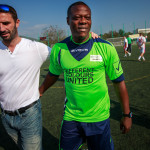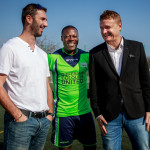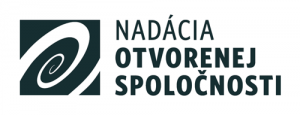Racism and extremism at stadiums need more attention, says a sports journalist
EEA, Fond pre MVO
Approximately forty future journalists and TV editors from the Department of Journalism at Comenius University in Bratislava attended a workshop called Media Versus Racism and Extremism in Sports, organized by the Institute for Intercultural Dialogue (Inštitút pre medzikultúrny dialóg, IPMD).
Approximately forty future journalists and TV editors from the Department of Journalism at Comenius University in Bratislava attended a workshop called Media Versus Racism and Extremism in Sport, organized by the Institute for Intercultural Dialogue (Inštitút pre medzikultúrny dialóg, IPMD).
The event took place within the IPMD project Sport Unites – More Colours, One Game, supported by the NGO Fund.
“Within the project, we monitor racism and intolerance expressions at stadiums, similarly to students who will soon become journalists and watchdogs of democracy. We discussed examples that had occurred, analysed how journalists handled the topic and how the media informed about the events, “ says Sergej Danilov, co-founder of the campaign and co-organizer of the event.
One of the students believes that more active football players should participate in campaigns against racism and hatred, just as they do in the Champions League.
Martia Jaures, Congolese amateur football player of the multicultural Different Colours United team was one of the panellists at the academic ground.
“I see that Slovakia is making progress in tolerance, but unfortunately, I still come across racist behaviour,” says Jaures. He thinks that media should try to influence the public in handling the issue.
Marek Majerčák, representative of the Slovak Football Association, recommended young journalists not to scandalize such topics in their daily practice. Other panellists shared their experience too, e.g. Michal Trško, editor-in-chief of the sport.inak portal and editor-in-chief of sme.sk, Vladimír Pančík, football commentator at RTVS and Michal Zálešák from IPMD.
Pančík mentioned several affairs of promoting neo-Nazism at stadiums by the ultras fans that were discussed in media, but solutions that would stop them have been only temporary. Pančík added that whenever he is present at the stadium, he does not ignore racism.
As Trško said, racism and extremism in sport are discussed by journalists much less than is necessary: “Sports journalists do not want to get in conflicts with football officials, fans or players. But if it is not us who discusses the issues, who will explain to the youth that extremist behaviour or vandalism at stadiums are not okay?”
Author: IPMD
We have Slovak ultras folklore at our stadiums, says Sergej Danilov
We talked to the organizer of antiracist football tournaments, SERGEJ DANILOV, about radicals at stadiums, the inactivity of clubs and the toothless law on extremist expressions in football adopted during the socialist regime.

Sergej Danilov
Do the Slovak media inform about racism and extremism in sport?
“I would divide it into two parts. Sport in media is covered by sports journalists, who focus on results and performance of sportsmen, clubs and national teams. They rarely write about racism and extremism, which are currently visible especially in football. When media do inform about this topic, national news journalists are usually the ones covering it, especially after an incident or aggression occurs at a match. In Slovakia, almost no journalists deal with extremism and racism in sport in an investigative way, although there are positive examples of political journalists who notice the ultras incidents once they are striking, such as promotion of neo-Nazi symbols, anti-Semitism or extremist behaviour.”
Is that sufficient to cover extremism and racism in sport by the media?
“It might be helpful if sports journalist had a look at the behaviour of fans at matches, apart from reporting sports results. At least it would keep reminding the public about the current situation. It is important to say that it is not the media’s task to solve the issues of racism and extremism in Slovak football. It is up to the clubs, League Clubs Union, the Slovak Football Association (SFA), police and fans. There are certain relationships which do not work well among these key players. I think that the clubs should give a choice to their fans – either you come to support your club or go and spread your hatred somewhere else. They need to actively select the type of fans they are interested in.”
What is the situation like abroad?
“We have an act that is not enforced as it should be, as the SFA has already pointed out. Instead of entry prohibition, we make hooligans pay fines, certain ultras groups are allegedly not willing to buy tickets for a specific name. In other countries, there is a rule stipulating that convicted hooligans must report to a police station during their club’s matches. This is a way how to stop such people from going to the stadium.”
There is a rule saying that if an incident occurs at an international match, television cameras must not display any fights. This is what happened during the last year’s match between Slovan Bratislava and Sparta Prague.
“I’ve never focused on this in detail. If the conflict is not shown by the cameras during the match, people will see it in the news the following day or even on the very same day on social networks. It is essential to focus on avoiding conflicts and not to censor their display. This is what I was talking about a while ago. Aggression in sport is discussed by the media in news coverage, but nobody analyses whether the clubs are ready for conflicts and fights between radical fans. The match that you mentioned was a complete fail and it resulted in the entry of decent fans onto the pitch because they were running away from aggressors.”
Has the attitude of fans and clubs in Slovakia towards racism and extremism changed in the past ten years?
“I would love to say that it has, but sometimes I doubt it. A positive example is Žilina, where they started to select fans to certain extent. Those who do not want to respect the rules are not allowed to the stadium. I heard that such people were told that the club is not interested in them going to the match. Since then, Žilina hooligans have boycotted the club. However, I don’t think that it has done any harm to the club. Sometimes aggression at stadiums must be suppressed by the police. The most risky fans are the ultras of Trnava and Slovan Bratislava, Dunajská Streda has a very strong core of radicals too. Minorities such as Jews, Gypsies, Hungarians, they serve as vulgar words. This hate speech is very lively between competing ultras and it harms the atmosphere at stadiums. For example, Slovan fans yell at Trnava fans that they are Polish Jews, Spartak ultras respond by chanting blue Jews. They have been offending each other like this for several years now. In Dunajská Streda, the fans call everyone Gypsies and they answer by calling them Hungarians. I would say it is Slovak ultras folklore.”
Is it something typically Slovak or does it occur in the neighbouring countries too?
“In Poland, eastern Europe and Balkan countries, the situation is definitely not better. Sometimes similar problems occur in western countries as well.”
Your words remind me of the event in the 1980s, when Sparta Prague fans destroyed a train during their journey to Slovakia. The fans’ extremism was displayed in the cult film Proč (Why). It seems to me as if nothing has changed since those days.
“Yes, because the nature of totalitarian regimes is very close to people who call themselves ultras. Neo-Nazis openly criticize the system in which they live, but if they came to power, they would probably establish an even more authoritarian regime. Nationalistic chants and nationalism were present at matches even in socialism. Among the core fans of Dunajská Streda or Slovan Bratislava, nothing has changed even after 1989. Communists tried to keep them on a leash, but the shouts at stadiums were similar, maybe just in a different form.”
Last year, media wrote about a huge scandal of RTVS sports presenter Kristína Kormúthová, earlier this year there was a conflict of our football players Vladimír Weiss jr. and Filip Šebo in a kebab bistro. Were these incidents expressions of extremism and racism in sports, too?
“Kormúthová definitely offended a person based on their race. It was an expression of dehumanization similar to those of extreme right groups, whether it was intended or not. It is dangerous and wrong when a celebrity uses the language of radical groups and suppresses fundamental human rights…”
And the affair of Weiss jr. and flying chairs?
“In this case I do not think it was extremism or attack on minorities. It was an incident of aggression. A group of people together with a Slovak national footballer caused trouble in a kebab bistro. At least I hope that it was without any such motives.”
Were the reactions of responsible bodies – RTVS in Kormúthová case and the SFA with Weiss jr. – adequate?
“The management of the Slovak national television and radio acted quickly and strictly. With Weiss jr. I have not seen a strong signal on behalf of the SFA. Just after the incident, the player himself published a tweet offending the victim, which he later deleted, probably as a result of the pressure from the public and media. Instead of saying he was sorry, he called the victim a junkie, which is not really an expression of Weiss’ empathy. And this is not a good attitude of a Slovak national team player who should act as a role model for young people.”
Can we use sport as a tool against racism?
“I don’t know if against racism, but prejudice? Definitely. Sport unites people much more easily than any discussion, although that might be effective too. Take football. It has clear rules which apply to everyone on the pitch. I see it during our football tournaments where many various people meet. If they talked about religion or politics, they would probably argue. But football unites them. It is a paradox, because there are times when football causes many conflicts and attracts radicals. But the game itself is not to blame. We use it as a tool to destroy prejudice. Nowadays a black football player can be a popular star and gain worldwide respect with his skills, which might even help minorities in the country. European teams are very diverse too, just look at the national teams of England, Germany, France or Italy.”
How does a common fan feel when a player who is black or comes from a minority surrounding joins “their” club and he is successful?
“A common fan is totally okay with it and does not care about the origin or skin colour. And later, once the player is successful, his achievements and club victories can silence people who spread hatred. However, sometimes it can turn against the player if he’s not successful. In that case, radical voices are very loud and the player can fall into disgrace of the public. It is interesting that the ultras might like a minority player in their team, but that does not stop them from offending other players of the same ethnic group or skin colour. Recently, Dunajská Streda played against Slovan in Bratislava and Lester Peltier was a target of monkey shouts from visitors’ fans. But at the same match, there was a Cameroonian national playing for Dunajská Streda, Noé Achille Kwin. I find it incomprehensible.”
For eight years you have been organizing antiracist football tournaments. What have you managed to change so far?
“We organize them in autumn during FARE action days, which is an initiative in forty countries and we are the ones supporting it in Slovakia. We believe that this year in October, many others will join us. It is not only about our tournament, in total, ten or twelve smaller events take place within two weeks in October all around the country. I am happy that we are able to unite people of different races, origins, religions, as this connection unites us. We always try to give space to current topics. Last year we invited Roma people from Moldava who were beaten by the police and Radovan Richtárik with his team. Richtárik is the owner of the Mariatchi club in Nitra, which was destroyed by the neo-Nazis. We want to show the public that we support these people. For the first time, we opened the tournament to clubs from the public. That attracted higher number of people and in one day, we coordinated a tournament of 18 teams on three pitches.”
What activities are you planning for this year?
“I am very glad that the workshop at the Department of Journalism at Comenius University was a success. We managed to attract 40 future journalists and that is very valuable to us. We are a watchdog organization monitoring expressions of racism and extremism at stadiums and they are watchdogs of democracy. They got to know something about the reality directly from people working in the field. Now we are preparing a book called Parent’s and Teacher’s Guide to Right-Wing Extremism for schools, we are going to launch a social media campaign against hate speech and radical rhetoric, a football tournament Street Champion League for children from socially disadvantaged families and together with No Mantinels Theatre, we organize an exhibition against homophobia. In autumn, there will be the tournament that we mentioned.”
Photo: Tomáš Benedikovič
Author: Rudolf Sivý 25.05.2015

















